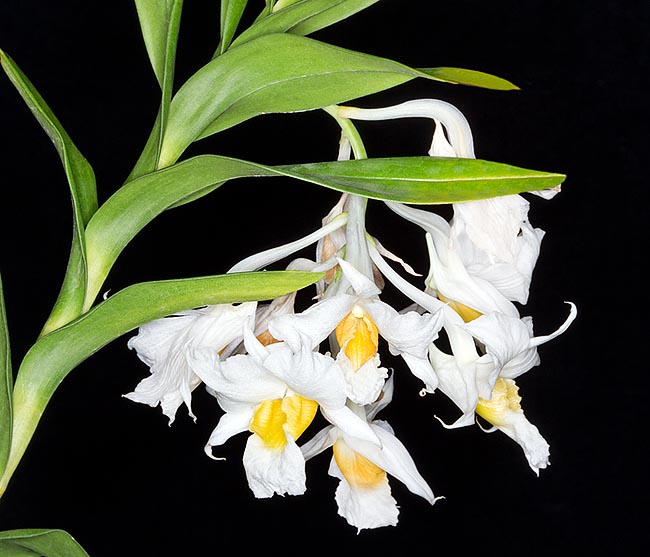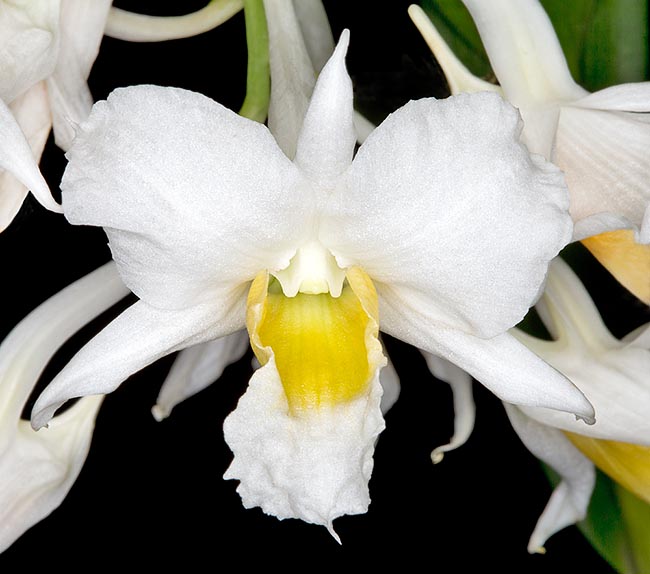Family : Orchidaceae

Text © Pietro Puccio

English translation by Mario Beltramini

Native to Philippines, Dendrobium dearei is an epiphyte with 0,4-1 m erect bseudobulbs © Giuseppe Mazza
The name of the genus is the combination of the Greek substantives “δένδρον” (dendron) = tree and “βίος” (bios) = life, with reference to the numerous species of the genus living on the trees; the species was honoured by H.G. Reichenbach to the English colonel Deare, collector of orchids, from whom he had received the plant.
Common names: Deare’s dendrobium (English).
The Dendrobium dearei Rchb.f. (1882) is an epiphytic species with cylindrical erect pseudobulbs, grooved, 0,4-1 m long, provided for almost all their length with persistent alternate leaves, distichous, oblong, 5-12 cm long and 2-4 cm broad, coriaceous, with the foliar base wrapping the pseudobulb covered by blackish down.
Racemose inflorescences from the upper nodes, compact, carrying up to 15 white flowers of 5-7 cm of diameter with a green spot of yellowish green at the base of the labellum.
Ovate sepals with pointed apex, 2,5 cm long and 0,6 cm broad, the two lateral ones merged at the base of the column, form a sort of a spur (mentum) about 1 cm long, ovate petals with obtuse apex, 2,5-3,4 cm long and 2,6 cm broad, trilobed labellum about 3,5 cm long and 2,4 cm broad with small, erect, and ovate median lobe with ruffled margins. The flowers are slightly perfumed and are long-lasting, more than one month.
It reproduces by seed, in vitro, and division, to be done at the vegetative restart, with each section provided of at least 3-4 pseudobulbs.

It's budding more times a year, with inflorescences bearing up to 15 long lasting flowers of 5-7 cm of diameter © Giuseppe Mazza
It requires high luminosity, also direct sun in winter, medium-high temperatures in summer, 22-30 °C, cooler, as an average, in winter, with lowest night values of 14-16 °C to stimulate the blooming, constant high humidity, 60-80%, with continuous air movement.
The waterings must be abundant during the growth, but allowing the roots to dry up before giving water again, slightly more spaced during the vegetative stasis, ad it does not need a precise resting period.
For the waterings and the nebulisations it is better to use rainwater, demineralised or by reverse osmosis; for the fertilizations, duly alternate with the waterings in order to avoid salts accumulation at the roots, is advisable the use of hydrosoluble balanced products, with microelements, at half the dosage shown in the instructions on the package.
It is cultivable in pot with compost that can be formed by medium sliced bark fragments and charcoal with addition of inerts, such as polystyrene, for an optimal drainage and for favouring the aeration of the roots, or mounted on trunks, bark, cork or arborescent rafts. The repottings are to be done during the vegetative restart when the compost begins to loose its draining properties.
The species is reported in the appendix II of the CITES (species whose trade is internationally ruled).
Synonyms: Callista dearei (Rchb.f.) Kuntze (1891).
→ For general notions about ORCHIDACEAE please click here.
